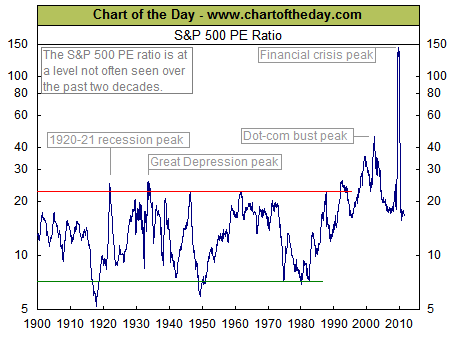 |
S&P500
PE Ratio Chart ==> Historical Graph of S&P500 Price Earnings Ratio 1900 to 2011 <== |
 |
|
|
||
Historical
CD Rates |
Crude Oil - Crude Oil ETFs for current prices and Inflation Adjusted Oil Prices |
|
|
Today's chart
illustrates how the recent rise in earnings has impacted the current
valuation of the stock market as measured by the price to earnings
ratio (PE ratio). Generally speaking, when the PE ratio is high, stocks
are considered to be expensive. When the PE ratio is low, stocks are
considered to be inexpensive. From 1900 into the mid-1990s, the PE
ratio tended to peak in the low to mid-20s (red line) and trough
somewhere around seven (green line). The price investors were willing
to pay for a dollar of earnings increased during the dot-com boom (late
1990s), surged even higher during the dot-com bust (early 2000s), and
spiked to extraordinary levels during the financial crisis (late
2000s). As a result of the recent surge in corporate earnings, the PE
ratio has dropped to a level that has rarely existed over the past two
decades.
 |
|
| Source: Chart of the Day
(using data from the National Bureau of Economic Research) Journalists and bloggers may post the above free Chart of the Day on their website as long as the chart is unedited and full credit is given with a live link to Chart of the Day at http://www.chartoftheday.com. |
|